Items
Tag
Ancient
-
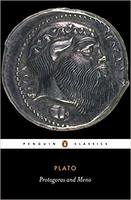 Protagoras “Widely regarded as his finest dramatic work, the Protagoras, set during the golden age of Pericles, pits a youthful Socrates against the revered sophist Protagoras, whose brilliance and humanity make him one the most interesting and likeable of Socrates' philosophical opponents, and turns their encounter into a genuine and lively battle of minds.”
Protagoras “Widely regarded as his finest dramatic work, the Protagoras, set during the golden age of Pericles, pits a youthful Socrates against the revered sophist Protagoras, whose brilliance and humanity make him one the most interesting and likeable of Socrates' philosophical opponents, and turns their encounter into a genuine and lively battle of minds.” -
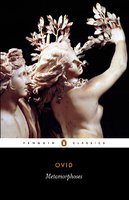 Metamorphoses “Ovid’s sensuous and witty poem brings together a dazzling array of mythological tales, ingeniously linked by the idea of transformation—often as a result of love or lust—where men and women find themselves magically changed into new and sometimes extraordinary beings. Beginning with the creation of the world and ending with the deification of Augustus, Ovid interweaves many of the best-known myths and legends of ancient Greece and Rome, including Daedalus and Icarus, Pyramus and Thisbe, Pygmalion, Perseus and Andromeda, and the fall of Troy. Erudite but light-hearted, dramatic and yet playful, Metamorphoses has influenced writers and artists throughout the centuries from Shakespeare and Titian to Picasso and Ted Hughes.”
Metamorphoses “Ovid’s sensuous and witty poem brings together a dazzling array of mythological tales, ingeniously linked by the idea of transformation—often as a result of love or lust—where men and women find themselves magically changed into new and sometimes extraordinary beings. Beginning with the creation of the world and ending with the deification of Augustus, Ovid interweaves many of the best-known myths and legends of ancient Greece and Rome, including Daedalus and Icarus, Pyramus and Thisbe, Pygmalion, Perseus and Andromeda, and the fall of Troy. Erudite but light-hearted, dramatic and yet playful, Metamorphoses has influenced writers and artists throughout the centuries from Shakespeare and Titian to Picasso and Ted Hughes.” -
To One Who Said "You're a Prometheus in Words" N/A
-
Prometheus N/A
-
Dialogues of the Gods N/A
-
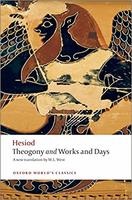 Works and days “…the Works and Days offers a compendium of moral and practical advice for a life of honest husbandry.”
Works and days “…the Works and Days offers a compendium of moral and practical advice for a life of honest husbandry.” -
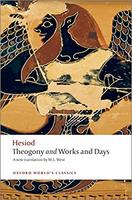 Theogony “The Theogony contains a systematic genealogy and account of the struggles of the gods …”
Theogony “The Theogony contains a systematic genealogy and account of the struggles of the gods …” -
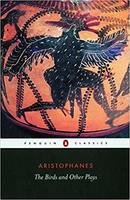 Birds " In The Birds, two cunning Athenians persuade the birds to build the utopian city of 'Much Cuckoo in the Clouds' in the sky, blockading the Olympian gods and installing themselves as new deities.”
Birds " In The Birds, two cunning Athenians persuade the birds to build the utopian city of 'Much Cuckoo in the Clouds' in the sky, blockading the Olympian gods and installing themselves as new deities.” -
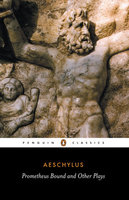 Prometheus Bound “Aeschylus (525–456 BC) brought a new grandeur and epic sweep to the drama of classical Athens, raising it to the status of high art. In Prometheus Bound the defiant Titan Prometheus is brutally punished by Zeus for daring to improve the state of wretchedness and servitude in which mankind is kept."
Prometheus Bound “Aeschylus (525–456 BC) brought a new grandeur and epic sweep to the drama of classical Athens, raising it to the status of high art. In Prometheus Bound the defiant Titan Prometheus is brutally punished by Zeus for daring to improve the state of wretchedness and servitude in which mankind is kept." -
 The creation of man by Prometeus “Prometeus, seated, is intent on observing his creature; the man, still a motionless clay puppet, stiffly lying at his feet, is surrounded by the greatest deities of the Greek pantheon. In a pre-eminent position there are Hera and Zeus in the act of giving Hermes the money with which to redeem the life of man from the Hades. Next to Hermes there is Poseidon with his trident; in the two upper corners, the chariot of Selene and the chariot of Apollo between Zeus and the man; finally, the Erotes induce Psyche, the soul, to give birth to the first human being.”
The creation of man by Prometeus “Prometeus, seated, is intent on observing his creature; the man, still a motionless clay puppet, stiffly lying at his feet, is surrounded by the greatest deities of the Greek pantheon. In a pre-eminent position there are Hera and Zeus in the act of giving Hermes the money with which to redeem the life of man from the Hades. Next to Hermes there is Poseidon with his trident; in the two upper corners, the chariot of Selene and the chariot of Apollo between Zeus and the man; finally, the Erotes induce Psyche, the soul, to give birth to the first human being.” -
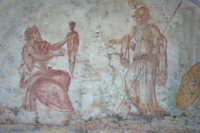 Untitled fresco “Roman fresco depicting Prometheus creating man in the presence of Athena, from the arcosolium of a tomb near the Basilica of St. Paul, 3rd century CE. (Museo della Via Ostiense, Rome).”
Untitled fresco “Roman fresco depicting Prometheus creating man in the presence of Athena, from the arcosolium of a tomb near the Basilica of St. Paul, 3rd century CE. (Museo della Via Ostiense, Rome).” -
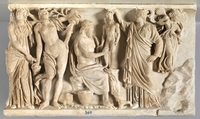 Prometheus models the first man “This fragment of a Roman sarcophagus depicts the Titan, Prometheus, modelling a statue of a nude youth. Minerva touches its head with a butterfly (psyche in Greek, meaning soul), bringing it to life. The action takes place in a natural setting, with a naked river nymph and a clothed tree nymph.”
Prometheus models the first man “This fragment of a Roman sarcophagus depicts the Titan, Prometheus, modelling a statue of a nude youth. Minerva touches its head with a butterfly (psyche in Greek, meaning soul), bringing it to life. The action takes place in a natural setting, with a naked river nymph and a clothed tree nymph.” -
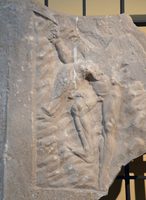 Untitled relief “Relief decorating the seating area entrances of the Roman Amphitheatre of Capua (Italy). It depicts Prometheus having his liver eaten by an eagle. Age of Hadrian (117-138 CE). (Capua Gladiator Museum)”
Untitled relief “Relief decorating the seating area entrances of the Roman Amphitheatre of Capua (Italy). It depicts Prometheus having his liver eaten by an eagle. Age of Hadrian (117-138 CE). (Capua Gladiator Museum)” -
 Untitled gem “Gem of glass paste imitating sard, engraved with Herakles with a bow, lion-skin and club; before him sits Prometheus, draped about the legs, with his hands chained above his head.”
Untitled gem “Gem of glass paste imitating sard, engraved with Herakles with a bow, lion-skin and club; before him sits Prometheus, draped about the legs, with his hands chained above his head.” -
 Untitled scarab “Sard cut scarab engraved with a seated Prometheus making man: he attaches an arm to a skeleton. There is an inscription.”
Untitled scarab “Sard cut scarab engraved with a seated Prometheus making man: he attaches an arm to a skeleton. There is an inscription.” -
 Herakles liberating Prometheus
Herakles liberating Prometheus -
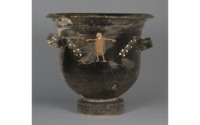 Gnathian Bell Krater “Black body with tendril of ivy leaves and grape clusters in added white. On the front, a figure of an old man with a swollen belly and an oversize phallus wearing a cloak stands in a rocky landscape. His wrists are bound. Below him to left is a crow. The scene is a parody of Prometheus bound to a rock having his liver eaten by an eagle.”
Gnathian Bell Krater “Black body with tendril of ivy leaves and grape clusters in added white. On the front, a figure of an old man with a swollen belly and an oversize phallus wearing a cloak stands in a rocky landscape. His wrists are bound. Below him to left is a crow. The scene is a parody of Prometheus bound to a rock having his liver eaten by an eagle.” -
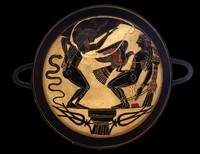 Laconic Kylix with Prometheus and Atlas “On this item we are able to admire one of the first known illustrations of the myth of Atlas, possibly directly inspired by the Theogony of Hesiod. Bearded Atlas bends at the knees under the weight of the heavenly vault dotted with stars that he has to carry, having been condemned by Zeus to keep heaven and earth separated. His punishment is associated with that of another Titan, his brother Prometheus, guilty of having given fire to man, and therefore bound to a pole and subjected to perpetual torture: an eagle pecks at his liver, which then regrows every night, only to be eaten again the following day. The linear plane on which the two Titans are depicted, possibly symbolising the Earth, rests on an imposing Doric column from which two lotus buds branch. The snake on the left may constitute a reference to the subterranean sphere of the underworld.”
Laconic Kylix with Prometheus and Atlas “On this item we are able to admire one of the first known illustrations of the myth of Atlas, possibly directly inspired by the Theogony of Hesiod. Bearded Atlas bends at the knees under the weight of the heavenly vault dotted with stars that he has to carry, having been condemned by Zeus to keep heaven and earth separated. His punishment is associated with that of another Titan, his brother Prometheus, guilty of having given fire to man, and therefore bound to a pole and subjected to perpetual torture: an eagle pecks at his liver, which then regrows every night, only to be eaten again the following day. The linear plane on which the two Titans are depicted, possibly symbolising the Earth, rests on an imposing Doric column from which two lotus buds branch. The snake on the left may constitute a reference to the subterranean sphere of the underworld.”